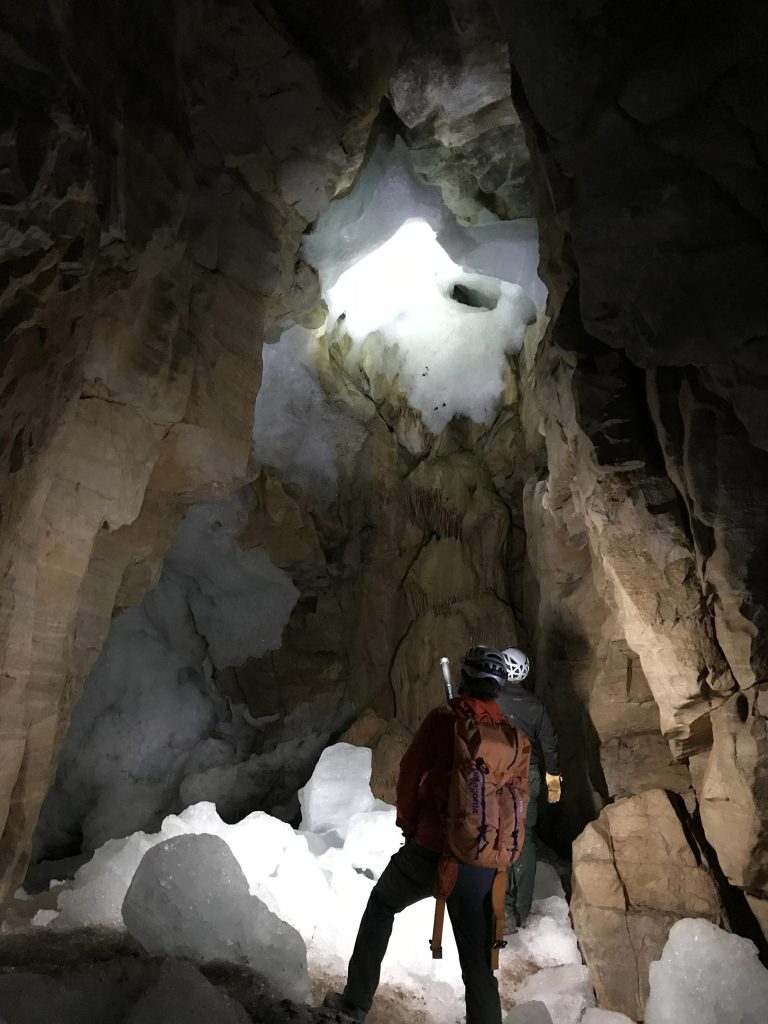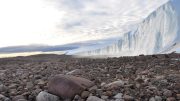
Researchers from the US and Canada found evidence in mineral deposits from caves in Canada that permafrost thawing took place as recently as 400,000 years ago, in temperatures not much warmer than today. But they did not find evidence the thawing caused the release of predicted levels of carbon dioxide stored in the frozen terrain. Credit: Jeremy Shakun, Boston College
Cave deposits reveal Pleistocene permafrost thaw, absent predicted levels of CO2 release.
The vast frozen terrain of Arctic permafrost thawed several times in North America within the past 1 million years when the world’s climate was not much warmer than today, researchers from the United States and Canada report in today’s edition of Science Advances.
Arctic permafrost contains twice as much carbon as the atmosphere. But the researchers found that the thawings — which expel stores of carbon dioxide sequestered deep in frozen vegetation — were not accompanied by increased levels of CO2 in the atmosphere. The surprising finding runs counter to predictions that as the planet warms, the volume of these natural carbon stores can add significantly to CO2 produced by human activity, a combination that could increase the climatological toll of greenhouse gases.
The team of researchers explored caves in Canada to look for clues left in speleothems — mineral deposits accumulated over thousands of years — that might help answer when in the past Canadian permafrost thawed and how much warmer was the climate, said Boston College Associate Professor of Earth and Environmental Sciences Jeremy Shakun, a co-author of the study.
The team was following up on a 2020 study that dated samples from caves in Siberia. That research found records of permafrost thawing until about 400,000 years ago, but little since then. Since the study focused on only a single region, the researchers sought to expand the search for a more representative view of the Arctic region, said Shakun, a paleoclimatologist.
During the course of two years, the researchers dated 73 cave deposits from several now-frozen caves in Canada. The deposits offer tell-tale clues to climatological history because they only form when the ground is thawed and water is dripping in a cave. By dating the age of the speleothems, the scientists were able to determine when in the past the regions had thawed.
Shakun said the results are very similar to the earlier Siberian study, suggesting that Arctic permafrost became more stable over the ice age cycles of the past couple of million years.
But he said the team was surprised to find that many of the speleothems from the high Arctic turned out to be much younger than expected. Their relatively young ages mean permafrost thawing formed mineral deposits when the world was not much warmer than it is today.
Sediment cores from the Arctic Ocean hint at what might have been going on then.
“The summers were ice-free before 400,000 years ago,” Shakun said. “That would have heated the land up more during the summer and insulated it under deeper snows in the winter, causing the ground to thaw.”
That theory is cause for concern if correct, he added. “Half of the Arctic sea ice has disappeared since I was born, so this may be making the permafrost more vulnerable again.”
Second, records of the ancient atmosphere show that greenhouse gas levels were not any higher during the past intervals of permafrost thaw we identified — this is surprising because the standard view is that massive amounts of carbon should be released to the atmosphere when the permafrost thaws.
Shakun said the findings call for further research to understand what allowed the permafrost to thaw at times in the past when it was not much warmer, and why there is little evidence for a big carbon release at those times.
“These findings do not fit easily with typical global warming predictions for the future,” said Shakun. “They may mean that scientists have overlooked processes that will prevent permafrost thaw from causing a big spike in CO2 going forward. On the other hand, it might just be that the gradual thawing events in the past were slow enough that the CO2 they released could be absorbed by the oceans or plants elsewhere – a situation that may not apply to the much faster warming today.”
For more on this research, read Climate Change Concerns Rise As Cave Deposits Show Surprising Shift in Permafrost Over the Last 400,000 Years.
Reference: “Increasing Pleistocene permafrost persistence and carbon cycle conundrums inferred from Canadian speleothems” by Nicole Biller-Celander, Jeremy D. Shakun, David McGee, Corinne I. Wong, Alberto V. Reyes, Ben Hardt, Irit Tal, Derek C. Ford and Bernard Lauriol, 28 April 2021, Science Advances.
DOI: 10.1126/sciadv.abe5799
In addition to Shakun, co-authors of the report included David McGee, Ben Hardt and Irit Tal, of MIT, Alberto Reys, of the University of Alberta, Derek Ford, of McMaster University, Bernard Lauriol, of the University of Ottawa, former BC graduate student Nicole Biller-Celander and geologist Corinne Wong, formerly of BC.









A positive feedback methane (CH4) caused warming loop is what we have to worry about today because methane is a far more dangerous warming gas, than gradual release of carbon dioxide (CO2) was 400,000 year ago. More carbon exists in methane, than in oil and coal combined.
Since we are releasing CO2 into the atmosphere at a rate far faster than the oceans can absorb, or plants can sequester, we run the risk of beginning to warm the climate too fast for the methane being released by thawing permafrost to be destroyed in the atmosphere by sunlight.
Add the warming from carbon dioxide, to the warming caused by the much more efficient at trapping heat greenhouse gas, methane, from the thawing permafrost, and a positive feedback warming loop could begin. More methane escaping faster than it gets destroyed, causing more warming, which causes even faster methane release, which causes more and more warming. That could get out of control and devastate the tropics where billions of people now live, and where most food is grown. Deserts could expand to cover most of the land surface, as the temperature goes up, who knows how much.
The risk of such an occurrence is far too great to allow to possibly happen. So high altitude aerosol dispersion to limit further warming should begin as soon as possible, because once a positive feedback loop gets going, it might be impossible to stop. There is enough methane frozen in permafrost, and on the ocean floor, to make most of this planet uninhabitable, should it begin to enter the atmosphere faster than it is being destroyed by sunlight. Want to run that experiment?
There’s not a damn thing anyone can do to stop what is coming. Eggheads won’t say that. They need fear to get their paychecks. Just go on with your life and let people who like to worry do all the worrying. You can’t stop industry from polluting and blaming it on the little guy and taxing them isn’t the answer.
In the medieval warming period it was warm enough to grow barley and graze sheep and cattle in southwestern Greenland. The stone walls of the fields and barns from that period are still there today.This period lasted 300 years. It has not warmed to this level yet today. If any methane is to be released it would have come out during this warm period.
Methane, although a very efficient absorber, only absorbs in a very narrow band in the 3 micron range, so any radiation it thermalizes will be limited in quantity and as the case with CO2, this band will be quickly saturated.
Methane is oxidized to CO2 in the upper atmosphere by a photo-chemical process. That is why there is so little methane in the atmosphere despite lacking a biological removal mechanism.
The top warmist advocates have described the fuss being made about methane, mostly by media sources, as an embarassment to the cause. I assume because it is so wrong.
How is it that we’ve been programmed to believe that gases in the atmosphere are causal and not effect of “global warming ” . What a joke! Here’s some amazing points of interest relative to this hoax.
Plate Climatology Theory should reveal some amazing facts. Volcanism! Along with correlations of weather change relative to Berklande Currents. These are signatures of what we are now learning about the Electric Universe. Further, simple research of the past 600 million years of life on this planet reveal that CO2 was an effect of far greater abundance of life than exists in earth today. In order to enable these prehistoric super charged living environments , CO2 was necessary @ 5000 ppm or more, obviously! People don’t research to fetter out the facts anymore, Just ask any professional pot growers how they stay competitive buying industrial grade CO2 gas cannisters? H2O vapor is actually more than 95 percent of the green house gas that is held by our atmosphere.while CO2 is essentially a trace gas? What do you think is behind all this propoganda of anthropogenic global warming? It’s the global fuel and energy companies. They are quietly commoditizing CO2. Hahshahaha, it’ll end up on the commodities exchange someday. Why do you really think Bill Gates is buying up all the farmland? Controlling food source is tomorrow’s tyranny. And how do you control food production, it all begins with photosynthesis @CO2! Pretty valuable gas, isn’t it?
So, the permafrost thawed, releasing methane and carbon dioxide into the atmosphere 400,000 years ago. So all life on Earth died.
Oh, but wait . . . All life on Earth did not die. Life did just fine.
So why are the Chicken Littles declaring that all life on Earth is now going to die in a few years because the permafrost is thawing?
And don’t give me that BS about “it’s happening quicker than it did before.” 400,000 years between thaws is a blink of the geological and biological eye.
What’s really going to be funny is in a thousand years from now when all of our progeny say, “Wow, our ancestors sure were stupid. They predicted the end of the world, and yet here we all, half a trillion strong.”
Wow these comments are embarrassing. Anti intellectualism rules the day now. So many people so willing to claim themselves experts with no basis in science or reality. Admit that you don’t know anything about climate with you accounting degree and leave climate science to the climate science experts.
I get my science from AOC, who said the earth will end in 12 years…about 4 years ago. Since we have only 8 years left, and we’re back to befriending China who produces most our goods while creating greenhouse gas with abandon in the process…we should all give up this ‘negative Nancy’ dialog, just have fun for the eight years we have left,let the cows fart in peace, for crying out loud!